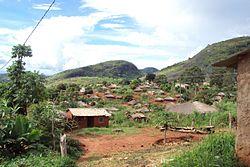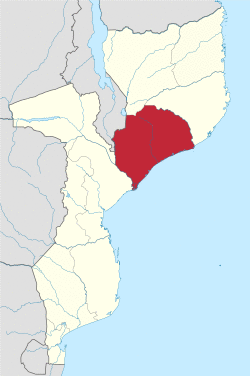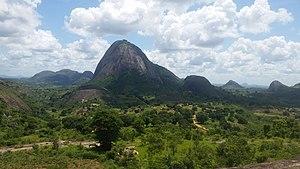Zambezia
| |
|---|---|
 | |
 Zambezia, Province of Mozambique | |
| Country | Mozambique |
| Capital | Quelimane |
| Area | |
| • Total | 103,478 km2 (39,953 sq mi) |
| Population (2017 census) | |
| • Total | 5,110,787 |
| • Density | 49/km2 (130/sq mi) |
| Time zone | UTC+2 (CAT) |
| Postal code | 24xx |
| Area code(s) | (+258) 24 |
| HDI (2017) | 0.407[1] low · 9th of 11 |
| Website | www |
Zambezia (Portuguese: Zambézia) is the second most-populous province of Mozambique, located in the central coastal region south-west of Nampula Province and north-east of Sofala Province. It has a population of 5,11 million (census 2017). The provincial capital is Quelimane on the Bons Sinais River.
Zambezia has a total area of 103,478 km²; much of it drained by the Zambezi River. Much of the coast consists of mangrove swamps, and there is considerable forest inland.
Agricultural products include rice, maize, cassava, cashews, sugarcane, soybeans, coconuts, citrus, cotton, and tea. The country's largest tea estates are at Gurúè, while Lioma is a centre of soybean production.[2] Fishing is especially productive of shrimp, and gemstones are mined at several sites.
Vasco da Gama landed at the site of Quelimane in 1498. Shortly after, the Portuguese established a permanent presence, and many moved up the Zambezi into the interior, for many years the farthest inland European presence (although over time there was much intermarrying, and few residents were of purely Portuguese descent).
Districts
Zambezia Province is divided into the 16 districts of:
- Luabo District -
- Alto Molocue District - with an area of 6,386 km² and 278,064 population,
- Chinde District - with an area of 4,403 km² and 121,173 population,
- Gilé District - with an area of 8,875 km² and 168,962 population,
- Gurué District - with an area of 5,606 km² and 302,948 population,
- Ile District - with an area of 5,589 km² and 292,504 population,
- Inhassunge District - with an area of 745 km² and 91,989 population,
- Lugela District - with an area of 6,178 km² and 137,040 population,
- Maganja da Costa District - with an area of 7,597 km² and 282,173 population,
- Milange District - with an area of 9,794 km² and 515,029 population,
- Mocuba District - with an area of 8,867 km² and 306,543 population,
- Mopeia District - with an area of 7,614 km² and 115,614 population,
- Morrumbala District - with an area of 12,972 km² and 361,896 population,
- Namacurra District - with an area of 1,798 km² and 179,133 population,
- Namarroi District - with an area of 3,019 km² and 127,651 population,
- Nicoadala District - with an area of 3,582 km² and 232,929 population,
- Pebane District - with an area of 9,985 km² and 186,330 population.
In addition, there is one municipality - the city of Quelimane - with an area of 117 km² and 192,876 population.
The above district populations are from the provisional results of the September 2007 Census.
Demographics
| Year | Pop. | ±% p.a. |
|---|---|---|
| 1980 | 2,500,200 | — |
| 1997 | 3,096,400 | +1.27% |
| 2007 | 3,890,453 | +2.31% |
| 2017 | 5,164,732 | +2.87% |
| source:[3] | ||
See also
- Postage stamps and postal history of Zambezia
References
- ^ "Sub-national HDI - Area Database - Global Data Lab". hdi.globaldatalab.org. Retrieved 2018-09-13.
- ^ Di Matteo, Otsuki & Schoneveld (2016), p. 68.
- ^ Cameroon: Administrative Division population statistics
Bibliography
- Di Matteo, Filipe; Otsuki, Kei; Schoneveld, George (2016). "Soya bean expansion in Mozambique: exploring the inclusiveness and viability of soya business models as an alternative to the land grab". In Ashley Lau; Jonathan Melo; Silvana Rebaza; Gabriela Smarrelli; Andrea Villarreal Ojeda; Zachary Clemence (eds.). The Public Sphere. LSE Africa Summit Edition 2016. Challenging Conventions (PDF). London: London School of Economics. pp. 61–86.
External links
- http://www.mozambique.mz/provinc/zambezia/eindex.htm
- (in Portuguese) Province of Zambezia official site
- (in Portuguese) Zambezia Online

.jpg)